FEW SENIOR coaches achieve success without making big calls, and Alastair Clarkson's time at Hawthorn has been characterised by a series of unflinching decisions.
On Saturday night at Domain Stadium, Clarkson will coach his 300th game, breaking John Kennedy snr's Hawthorn coaching record and becoming only the eighth man to coach 300 games at one club.
• The Chase: Clarkson's milestone and why it matters
On the eve of that milestone, here are the eight biggest calls that shaped Clarkson's coaching career and delivered the Hawks one of their most successful eras.
1) Reshaping the playing list in one summer
Lance Franklin, the No.5 selection in the 2004 national draft. All pictures: AFL Photos472.jpg)
Within weeks of settling into his new digs at Glenferrie Oval after the 2004 season, Clarkson gets to work, axing established senior players such as Kris Barlow, Mark Graham, Adrian Cox, Lance Picioane and Luke McCabe.
Delisting Graham, a popular 223-game stalwart, is seen as particularly shocking, but the Hawks are going to the draft and Clarkson nails it. He ignores Richard Tambling, the consensus No.2 pick, snookering Richmond in the process, and instead grabs Jarryd Roughead. Three picks later he picks Lance Franklin and two selections later, Jordan Lewis becomes a Hawk.
With Luke Hodge and Sam Mitchell already there and starting to shine, the foundations of one of the greatest teams of all time are laid in place.
2) Rolling the dice at the 2007 NAB AFL draft
A young Cyril Rioli in action for Clarkson's Hawks.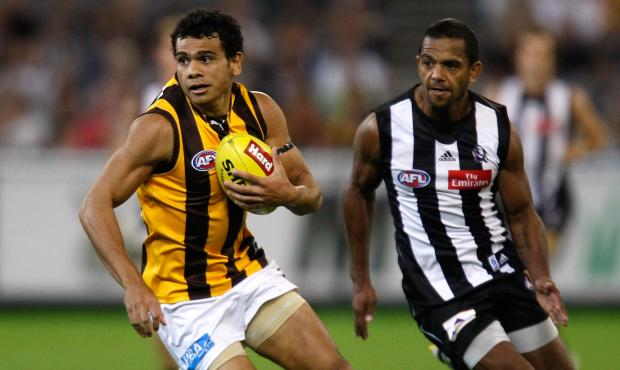
With their first pick the Hawks select the brilliant but seemingly disinterested Cyril Rioli. Given how poorly he tested in the lead-up, it's a gamble.
But with their third pick they select 2004 Port Adelaide premiership forward Stuart Dew who is 12 months into, shall we say, a 'well-lived' retirement. The move is widely ridiculed, helped along by some unflattering pictures on the back page of the Herald Sun. Clarkson rides him hard, but Dew responds, and they would soon have the last laugh.
Stuart Dew enjoys the spoils of Clarko's coaching genius.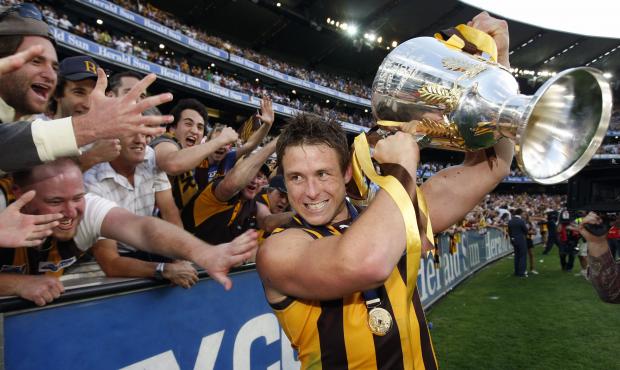
3) Inventing 'Clarko's cluster' …
In 2008, years of closely studying overseas sports, particularly soccer, inspires Clarkson to implement a rolling 15-player zone, designed to protect the middle of the ground when the Hawks don't have the ball.
Teams are forced to chip the ball around the flanks, but eventually they come unstuck. Orchestrating it all on the ground are Mitchell and Hodge, skilled and tough footballers with football IQs through the roof.
The Hawks are only in year four of their rebuild and their own modelling has them still a few years away from a flag contention, but they win through to the Grand Final where they frustrate Geelong – which had lost just one game all season – in the first half before kicking away in the second for an upset 26-point win. The much-maligned Dew kicks two goals in the third term and has a hand in two others.
4) … and abandoning it
Reinvention has become a trademark of Clarkson's coaching career.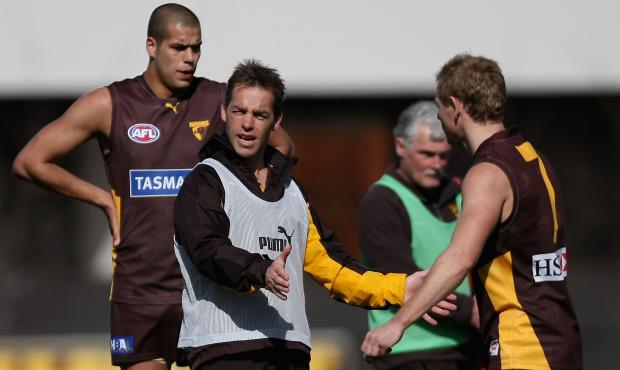
By 2010 the 'Cluster' has been worked out and some premature injuries and retirements have brought the Hawks back to the field.
After a dreadful 1-6 start to the season and with the axe hovering, Clarkson undertakes a drastic mid-season reshaping of Hawthorn's gameplan. Almost overnight the Hawks revert to a gameplan based around smart ball use and, in particular, using the elite kicking skills of the players brought to the club in recent seasons.
The Hawks end up winning 11 of their remaining 15 games to make the finals and then dominate the next five seasons.
5) Making the Hawks a destination club
Ex-Port Adelaide player Shaun Burgoyne, right, with Clarkson (centre).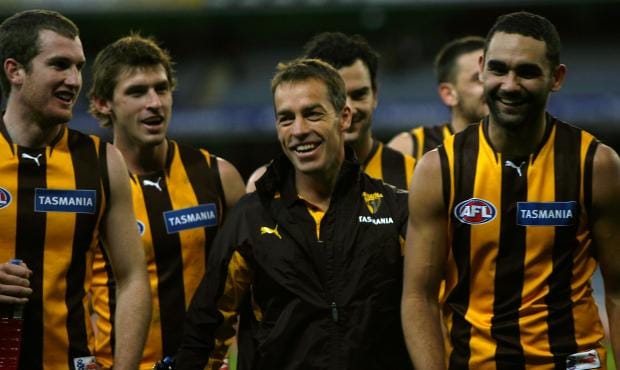
Clarkson understands that with the AFL committed to bringing two new teams into the competition, the bulk of the best young talent in the country will be heading straight to Gold Coast and Greater Western Sydney. So in 2010 he decides to replenish and improve his playing list with established players from other clubs, even if it means trading away multiple draft picks.
Shaun Burgoyne (Port Adelaide), Josh Gibson (North Melbourne), David Hale (North Melbourne), Jack Gunston (Adelaide) and Brian Lake (Western Bulldogs) would play in three premiership teams. Ben McEvoy (St Kilda) would win two flags while James Frawley (Melbourne) would feature in one.
The Hawks also recruit smartly with mature-aged recruits. Ben Stratton, Isaac Smith and Paul Puopolo would all play in the 2013-15 flag-winning teams.
6) Moving Franklin to the flank
'Buddy, we need to talk ...'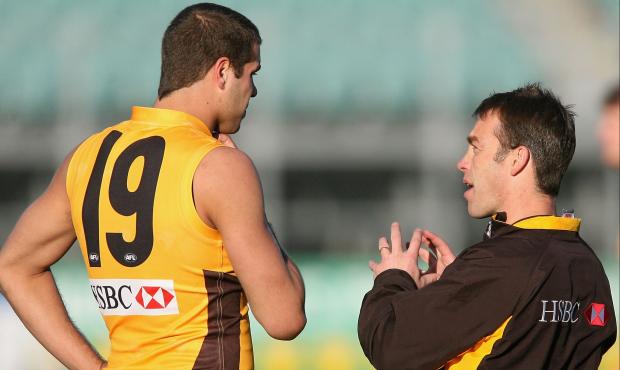
Hawthorn go close to winning the 2011 and 2012 premierships but the reviews after both seasons reflect an over-reliance on the mercurial Lance Franklin.
In a bold and gutsy move, Clarkson effectively sidelines Franklin in 2013, making him just another member of the forward line rotation rather than the focal point. It's partly to make the Hawks less predictable but also because Franklin is out of contract and would be out the door at the end of the season and Clarkson wants to minimise the fall-out from his departure.
The strategy works a treat as the Hawks break through to win the flag, demonstrating to themselves there would be life after the great No.23.
7) Building a football university
Clarkson, (l) with assistant Brendon Bolton and the 2014 Toyota AFL Premiership Cup.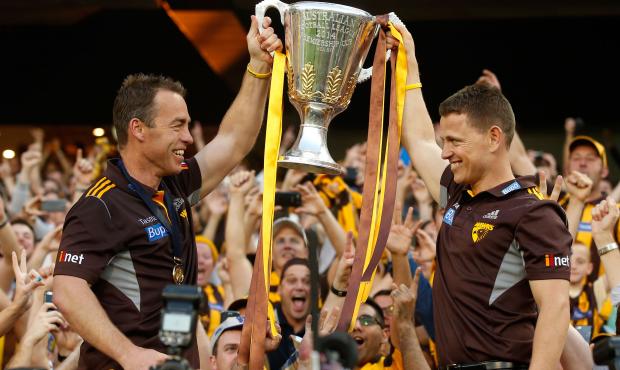
A teacher by trade, but also armed with an MBA, Clarkson creates a culture of excellence both on and off the field, one former head of football Chris Fagan would describe as a "football university".
In 2014, Clarkson is sidelined for five weeks with Guillain-Barre Syndrome, but the Hawks don't skip a beat, winning all five games with Brendon Bolton as stand-in senior coach. It's a case study of the Hawthorn machine at its best because they are also missing several important senior players at the time due to injury.
All up, six future AFL senior coaches – Damien Hardwick, Leon Cameron, Adam Simpson, Luke Beveridge, Bolton and Fagan would cut their teeth working underneath or (in Fagan's case) alongside Clarkson.
8) Trading Sam Mitchell and Jordan Lewis
Clarkson embraces Sam Mitchell after the 2015 premiership win. 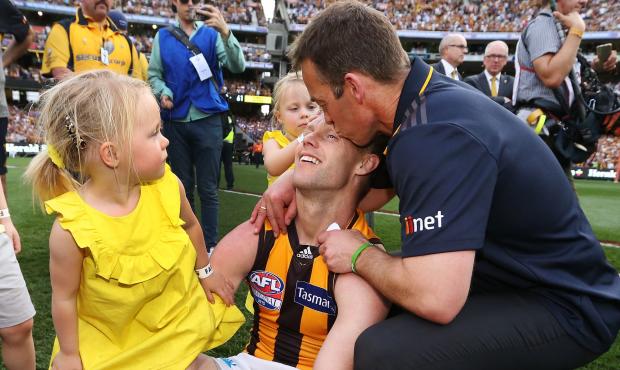
After winning three straight flags between 2013 and 2015, Clarkson goes against his natural inclination and kept the playing list intact for a push at becoming just the second team ever to win four flags on the trot.
The Hawks fall short at semi-final stage and then Clarkson goes to work, sending club champions Sam Mitchell and Jordan Lewis to West Coast and Melbourne respectively, both as a salary cap salve and also to allow the next generation of Hawks their overdue chance to play regular senior football.
He trades the club's 2016 first-round pick for Sydney's Tom Mitchell, which proves an inspired choice, while the 2017 first-round pick and some others depart the club in exchange for Jaeger O'Meara. It is a huge gamble and the gifted but hobbled former Gold Coast player plays just four games in the first half of 2017 because of more knee injuries.
However if he comes good – and the Hawks remain confident he will – they'll have shored up their midfield for the next five to eight years and Clarkson will be hailed as a genius once again. Already the Hawks appear to have bottomed out and are moving back up the ladder.
Read more
• The Chase: Clarkson's milestone and why it matters


